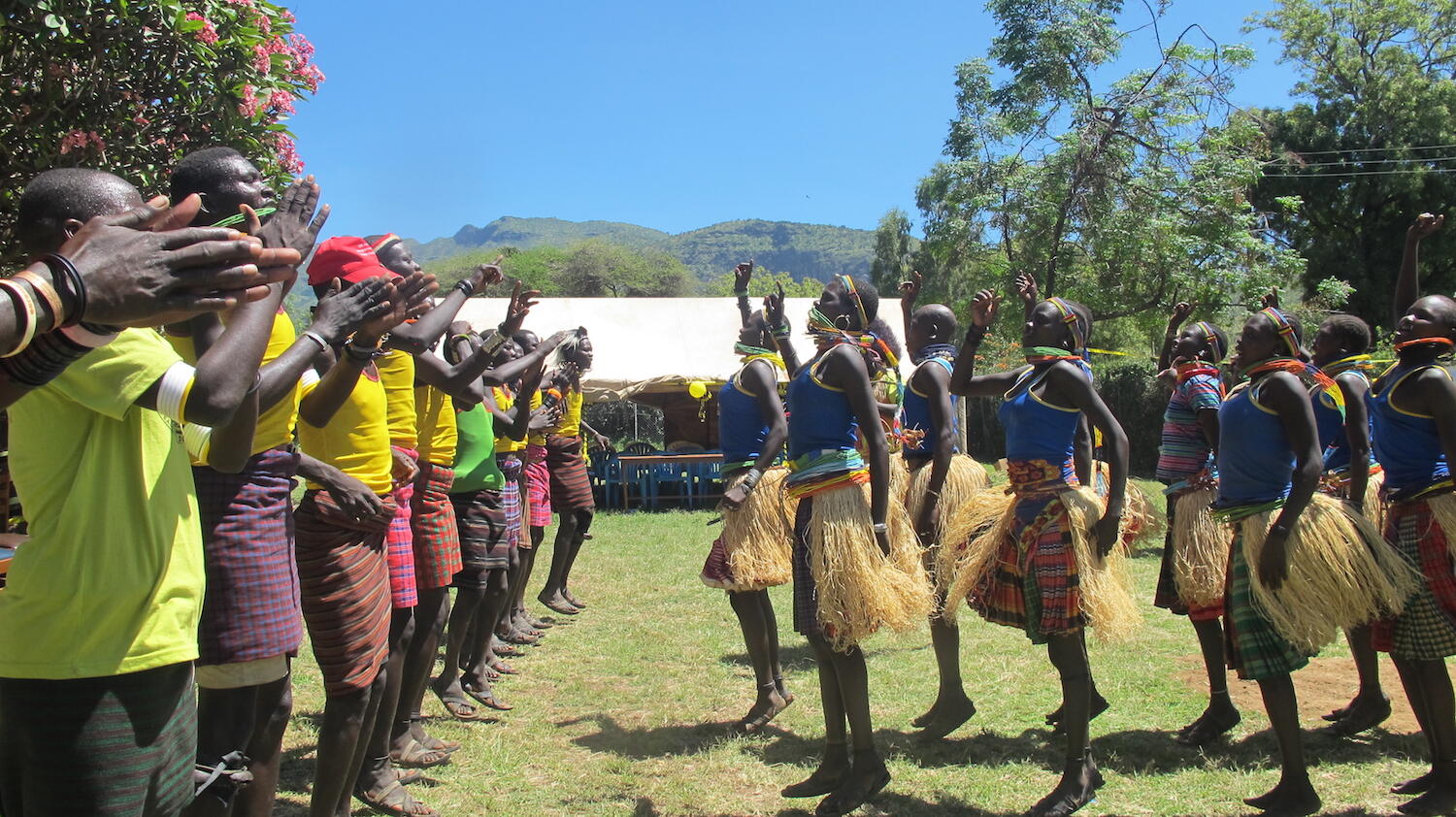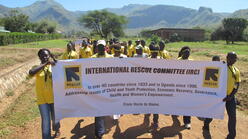
Over the past decade, the International Rescue Committee has been working with communities and tribal and cultural leaders in northern Uganda to reduce violence against women and girls and increase accountability of perpetrators.
I recently visited Karamoja, a region in northern Uganda about seven hours by jeep from Kampala, the capital. I wanted to be part of the celebration of the IRC’s first 10 years of work in this remote but beautiful area of Africa.
Karamoja, the poorest region in Uganda, ranks last in every area of development. Life expectancy is 47.7%* (compared to 50.4% nationally). Only 11% of children go to school (compared to 67% nationally). For centuries, the people of this region have been pastoralists, travelling with their cattle in search of water and pasture, but communities have begun to settle in more permanent villages. Shortages of food and water, poor roads and infrastructure, and poor maternal and child health have always been problems for these nomads, but unclean water and poor sanitation have become challenges as well. Only 10% of the newer, settled communities have access to latrines, compared to 30% for the rest of the nation.
In addition to the physical difficulties of their lives, Karamoja peoples have a long history of conflict. Tension between warring clans has been the norm for generations, with young “warriors” stealing cattle from rivals, sometimes crossing borders into neighbouring Kenya and South Sudan to do so.

The IRC has made it a priority to address root causes of conflict here. Women are central to the cycle of violence. On the one hand, they encourage men to raid as a way of establishing tribal power, even though they themselves are often victims of violence during raids. On the other hand, tradition in Karamoja discourages progressive-thinking women from acting as peacemakers.
The IRC’s Women Building Peace programme and the foundation Raising Voices have supported women’s engagement in peace building in Karamoja since 1999. The IRC implemented peace-building programmes in Karamoja with support from the U.S. Agency for International Development and the European Union. Raising Voices’ SASA! initiative takes a community-based approach to preventing violence against women and the spread of HIV. Both programmes strive to strengthen individual leadership skills and to challenge social norms that limit women’s abilities to advise on issues of conflict and security.
“We have a lot to celebrate.”
Denis Kotol oversees IRC’s programmes in Karamoja and is himself from the region. “Over the last 10 years, there have been a lot of changes. Karamoja was extremely insecure. Both national and international organisations were scared to come here. There were lots of illegal arms and rampant killings.”
Lucia Angella, 44, remembers what it was like before the IRC started working in the area. “When the men used to fight, it was the women who were affected,” she says, “During the raids we would be grabbed. Our belongings were stolen.” Life in Karamoja was bad generally. “You couldn’t walk for five kilometres on your own,” she recalls.
When the IRC arrived, Lucia became a peace committee member and, later, an active leader in SASA! She and her colleagues encouraged women and men to understand their differences and learn to work together for the greater good of families and the wider community.
Mary Longora, 21, is one of the youngest chairpersons of a SASA! group. A mother of two who was forced into marriage at 17, she decided to join the peace group after witnessing too much violence in her village.
“We talk with families and share with them the importance of peace in the family,” she says. “I am noticing more and more that most families are not as violent as before.” Her husband is pleased she is doing this work. “He is so happy and proud because he sees that I am helping others,” she says.
Mohamed Lomong recalls clearly when the IRC came to his area 10 years ago. “They talked about the importance of loving humanity,” he remembers. “I was selected as a peace activist for my village.”
He is also chairperson of a local SASA! group. “I really enjoy talking to the children and encouraging them to go to school,” he says, “and explaining that they should get along with one another and their parents.” In addition, Mohamed leads a peace choir made up of 15 men and 15 women. “Our sole intention is to get out there and sing songs with messages of peace,” he says proudly.
Mohamed believes that the IRC is crucial to the effort to bring peace and a new way of thinking to Karamoja. “The IRC included us in the peace process,” he says, “and we were able to talk to the warriors in the bush because we were trained to do so.”
Ayepa Cosmas Kolibi, vice chairperson of Moroto District Council, also believes that the IRC’s work has been inestimable. “Last month, I joined the IRC on a monitoring and evaluation visit of the community,” he explains. “I was so impressed to find out that my community is now extremely aware of issues relating to violence against women. Now, if you go out in the community, we can talk about such issues as well as HIV and AIDS. We are confident that women are becoming empowered.”
Ayepa even believes the centuries-old custom of female genital mutilation is beginning to fade. “Those that carry out these rituals are starting to hand in their tools,” he says. “This is a practice that we have been fighting against for a long time.”
Christine Lalobo, IRC’s country director in Uganda, was keen to mark this milestone. “Despite working in Uganda since 1998, we felt it extremely important to reflect and celebrate on our work here in Karamoja,” she says, lauding the dedicated efforts by the IRC staff. “As you have heard, the IRC has made a huge difference in the communities in Karamoja. But it is the people themselves who have worked tirelessly for change and peace in their homes and wider society. I am looking forward to the next 10 years and all that it is going to bring.”
*Statistics courtesy UNDP 2007 and UDHS 2006.
Article and photos: Sophia Jones-Mwangi.